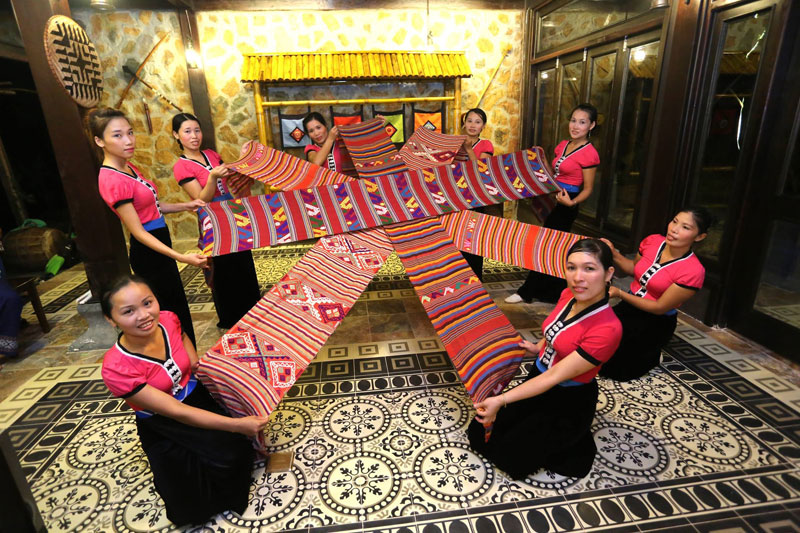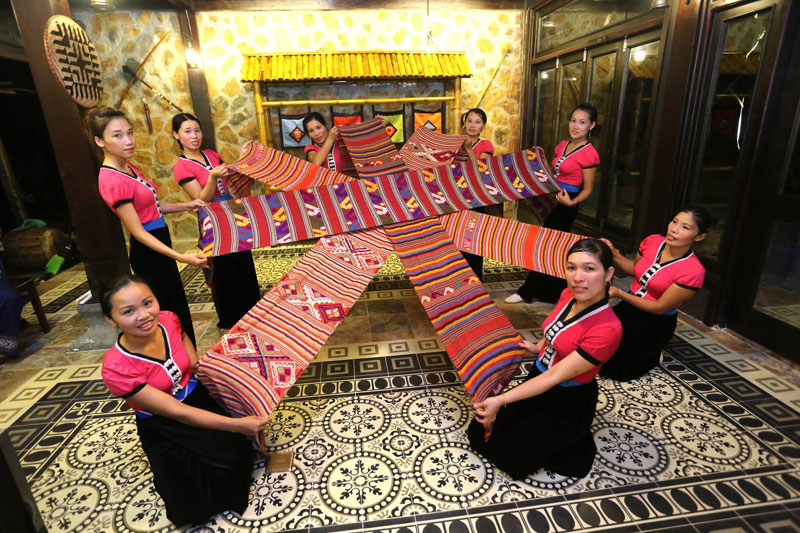
(HBO) - Xoe dancing originates from the working life, the customs and the traditions of the people. Ong Bong Xoe dancing (fanning) is a form of the ancient dance with simple movements. Everyone holds the hands and dance around the bonfire in the "cheering" and "ho huay" lyrics after hunting or celebrating a new home...
 The team of Xoe dancing in Mai Chau Ecolodge resort, Na Phon commune (Mai Chau) is performing to serve the tourists.
The team of Xoe dancing in Mai Chau Ecolodge resort, Na Phon commune (Mai Chau) is performing to serve the tourists.
Xoe after the gongs: hanging the drum and the gong under the head of the houses on the stilt, 1 or 2 guys beat the drum and the gong, dancing. For Xoe Vong dancing (swinging) boys and girls hold hands to form a circle to dance on the floor or in the yard, moving the clockwise on the occasion of the family’s or community’s good news.
Xoe dancing is not only culture and customs but it is also the identity, the lifestyle and the habits. Above all, Xoe dancing is an indispensable spiritual dish of the Thai ethnic people. Xoe dances of Thai ethnic people in Mai Chau have been preserved and developed over the time. Today, Xoe dances have been modified and more attractive than they used to be. Xoe dances have had more movements with beautiful costumes. For example, women are wearing colorful brocade scarves across the neck or holding a fan, holding a music to create funny sounds.
Currently, Mai Chau district preserves and promotes Xoe dancing of Thai ethnic people through the local cultural and artistic activities. There are 183 mass performance teams in the whole district to serve the district's political duties. The unique Xoe dances have also performed at the major events of the province. The mass performance teams have been established in every village of Thai ethnic people. Every day, the folk artists contribute their heart and soul to the traditional Xoe dance, which is the core of preserving, maintaining and developing Xoe art in the community.
In addition, in order to preserve Xoe dances of Thai ethnic people, the Party Committee and the authorities of Mai Chau district have associated the development of Xoe arts with the development of the community tourism. The villages of the community tourism of Thai people have set up a professional Xoe dancing club to perform for the tourists.
Typically, there are 6 Xoe dancing teams in Lac village, there are 2 Xoe dancing teams in Van village, there are 3 Xoe dancing teams in Pom Coong village. There are from 12 to 13 people in each Xoe dancing team. The graceful and funny movements of Xoe dancing create a magical attraction for the tourists whenever they pay a visit, experience and explore the culture of Thai ethnic people in Mai Chau.
Mr. Ha Cong Hoi, the homestay owner in Lac village, Chieng Chau commune says: Tourists coming to Lac village love to see Xoe dancing and participate in the dance. In the feeling of many tourists, coming to Mai Chau without being immersed in passionate Xoe dances with the charming Thai girls, the trip is not complete.
Grasping the psychology of the tourists along with the desire to preserve the cultural identity of the Thai ethnic group, the tourism households like my family often invite the professional Xoe dancing team to perform. When the night falls, the fire flickers with the hilarious sound of gongs and drums, Thai boys and girls and the tourists are immersed in Xoe dancing. The bigger the drum and gong sound is, the bigger is the circle of Xoe dancing. Everyone's hand in hand, regardless of the owner and the guests, they are happy to take part in Xoe dancing. Just like that, the circle of Xoe dancing like a string connecting people together.
The People’s Committee of Lac Son district held a ceremony on April 28 to receive the provincial relic certificate for the ancient rock carving site at Suoi Co stream, located in My Thanh commune.
A special music show titled "The country is in the fullness of joy” has been held at Hoa Binh Square in Hoa Binh city in celebration of the 50th anniversary of the liberation of the South and national reunification (April 30, 1975–2025).
The People's Committee of Lo Son commune, Tan Lac district, has organised the local annual traditional stream fishing festival on April 19 - 20.
As a land deeply intertwined with human history and Vietnam’s millennia-long journey of nation-building and defence, Hoa Binh is often revered for its epic tales and legends.
Residents of Hoa Binh boast a rich cultural identity, reflected in their unique language, traditional attire, customs, and folk melodies – described as "sweet as honey, clear as a mountain stream.”
Lac Son district’s Vu ban town held the 2025 Truong Kha temple festival on April 12–13 (the 15th–16th days of the third lunar month). Since its revival in 2019, the festival has been organised every three years, preserving valuable intangible heritage while meeting the community’s cultural and spiritual needs.



 The team of Xoe dancing in Mai Chau Ecolodge resort, Na Phon commune (Mai Chau) is performing to serve the tourists.
The team of Xoe dancing in Mai Chau Ecolodge resort, Na Phon commune (Mai Chau) is performing to serve the tourists.